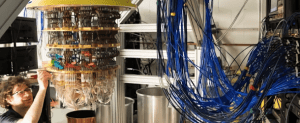Quantum News Briefs October 15: New Interface Uses Light to Scale Up Quantum Computers • USheffield Chooses Oxford Instruments NanoScience Equipment for £1M Ultra-Low Temperature Facility • Google’s Sycamore Quantum Chip Beats Classical Computers Running Random Circuit Sampling • Researchers Collaborate through Co-Design Center for Quantum Advantage Center to Bring Quantum Scaling Closer to Reality


Nu Quantum, a startup in England, says it has developed a quantum version of the network interface cards that connect servers together in data centers, as reported by Charles Q. Choi, a Contributing Editor for IEEE Spectrum on October 14 and summarized here.
The company’s goal is to help fuse today’s relatively small quantum processors into useful machines.
To overcome this obstacle, Nu Quantum has built a prototype qubit-photon interface to connect multiple quantum processors together. “We are there to develop the networking technology that can help the industry cross the scaling chasm it faces,” Palacios-Berraquero says. “Instead of trying to build bigger and bigger computers that are inefficient, that are one-off machines, we want to shift to modular, smaller quantum processing units that are more efficient and interconnected by a network.”
The new device is designed to entangle qubits with photons. These photons can then entangle with other qubits and so entangle all the qubits together. “It’s the first time in the history of the quantum industry where a company has built the equivalent of a network interface card,” Palacios-Berraquero says.
To boost qubit-photon entanglement, Nu Quantum wanted to control the length of these cavities to ensure they resonated with qubits. They stabilized the lengths of these cavities to 80 picometers, or less than the width of an atom. “Another way of thinking about it is how this is a millimeter-long cavity, so stabilizing it to 80 picometers is like knowing the height of the Empire State Building with the width of a human hair,” said Claire Le Gall, Nu Quantum’s vice president of technology.
USheffield Chooses Oxford Instruments NanoScience Equipment for £1M Ultra-Low Temperature Facility
 The University of Sheffield has opened a new ultra-low temperature facility for dark matter and qubit research, providing a hub for students in the UK and expanding the scope of quantum technology research at the university. The University selected the ProteoxMX, a state-of-the-art dilution refrigerator and superconducting magnet manufactured by Oxford Instruments NanoScience for its facility.
The University of Sheffield has opened a new ultra-low temperature facility for dark matter and qubit research, providing a hub for students in the UK and expanding the scope of quantum technology research at the university. The University selected the ProteoxMX, a state-of-the-art dilution refrigerator and superconducting magnet manufactured by Oxford Instruments NanoScience for its facility.
Funded by UK Research Councils (UKRI) through the Science and Technology Facilities Council (STFC), it is the first closed cycle dilution refrigerator at the University of Sheffield. The refrigerator will be utilised by the Quantum Sensors for the Hidden Sector (QSHS) collaboration, led by Professor Ed Daw.
The laboratory was officially opened in the School of Mathematical and Physical Sciences by Professors Ian Shipsey, Koen Lamberts and Ed Daw. The dilution refrigerator is allowing scientists to probe fundamental physics at the quantum level, search for dark matter, and nurture a new generation of young scientists in the North.
In Other News: Phys.org reports “Google’s Sycamore Quantum Chip Beats Classical Computers Running Random Circuit Sampling“
 A team of engineers, physicists and quantum specialists at Google Research has found that reducing noise to a certain level allows the company’s Sycamore quantum chip to beat classical computers running random circuit sampling (RCS) as reported by Bob Yirka in October 12 Phys.org.
A team of engineers, physicists and quantum specialists at Google Research has found that reducing noise to a certain level allows the company’s Sycamore quantum chip to beat classical computers running random circuit sampling (RCS) as reported by Bob Yirka in October 12 Phys.org.
In their study, published in the journal Nature, the group tweaked the conditions under which their processor was running to reduce the amount of noise interference to a level that allowed it to surpass classical computers running RCS.
Computer scientists have been trying to build a truly useful quantum computer for several decades, but they have yet to build one that delivers on its initial promise—to run algorithms that would take classical supercomputers hundreds, thousands or even millions of years to complete.
In this new study, the researchers at Google worked to reduce background noise, part of which involved putting their chip in a near absolute zero chamber as the chip was running. They found that even small reductions in noise, such as from a 99.4% error-free rate to 99.7%, resulted in dramatic changes in capabilities.
They were also able to reduce the error rate of their chip enough to allow it to achieve a “quantum advantage” when running the RCS—suggesting that scientists are moving ever closer to the dream of a truly useful quantum computer.
In Other News: PNNL Reports “Researchers Collaborate through Co-Design Center for Quantum Advantage Center to Bring Quantum Scaling Closer to Reality”
Researchers from 14 institutions collaborated through the Co-design Center for Quantum Advantage (C2QA), a Department of Energy (DOE), Office of Science, National Quantum Information Science Research Center to bring quantum scaling closer to reality as reported by Sara Wong Pacific Northwest National Laboratory on October 14.
Together, they constructed the ARQUIN framework—a pipeline to simulate large-scale distributed quantum computers as different layers. Their results were published in ACM Transactions on Quantum Computing.
The research team, led by Michael DeMarco from Brookhaven National Laboratory and the Massachusetts Institute of Technology (MIT), started with a standard computing strategy of combining multiple computing “nodes” into one unified computing framework.
No one institution could carry out the full breadth of research needed for the ARQUIN framework. The ARQUIN team included researchers from Pacific Northwest National Laboratory (PNNL), Brookhaven, MIT, Yale University, Princeton University, Virginia Tech, IBM, and more. the ARQUIN team broke down the problem of constructing a multi-node quantum computer into different “layers,” with each institution working on a different layer based on their area of expertise.
The ARQUIN framework focused on superconducting quantum devices connected by microwave to optical links. After compiling the different pieces of the project together, ARQUIN became a framework for simulating and benchmarking future multi-node quantum computers. This marks a promising first step toward enabling efficient and scalable quantum communication and computation by integrating modular systems.



















